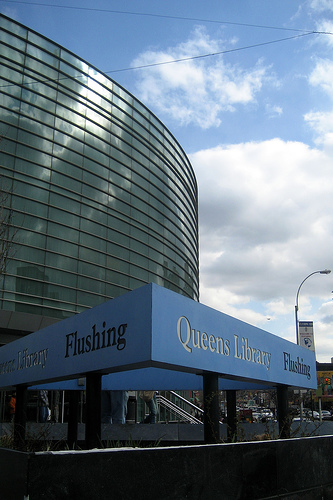From The Peopling of New York City
Contents |
Flushing Town Hall
History of the Town Hall
Construction of the Flushing Town Hall began in 1862. It was built for military and government use and was a meeting place designated for use by high American officials. The construction of the Town Hall was completed in 1864. From the very beginning, the town hall provided many different services to the Flushing community, including a bank, courthouse, and a library. In 1898 New York City was consolidated and the City took over the building. After the city took control of the town hall, it was never quite the same again. The building was tenanted by many different people, but it never reached it's prior glory. In 1967, the landmarks Preservation Commission gave the building protected status as an official landmark. In 1972, the National Park Service named the Town Hall a historic site. In 1990, the Flushing Council on Culture & Arts was chosen to manage the Town Hall, and renovated the building to be used as a multicultural arts center.
The Town Hall Now
The Town Hall is now open to the public again under the management of the Flushing Council on Culture and Art. Jazz, classical music and opera performances, as well as ethnic festivals, and fine art and historical exhibitions take place at The Town Hall. Currently the first floor includes art galleries, performing arts spaces, offices, and a visitors center. The Second Floor has a large theatre space that is often used for shows and performances.
How the Town Hall has been influenced by immigrants
The purpose of Flushing Town Hall is to ultimately serve their community, which is composed of a large mix of South Asians, Asians, and Hispanics. Their arts and cultural programs reflect the background of the community they live in, with annual lunar new year celebrations, and cultural celebration months. The Flushing Council on Culture & Arts aims to book culture-based award winning artists so that the community will come out and participate. The Town Hall is also open to many public workshops and educational programs. They have interactive arts programs, and recently worked with a Mandarin school in the area. They serve bilingual schools and have mixed English workshops with translators available as needed. All marketing materials are distributed in English, Spanish, Korean and Chinese in order to better reach and serve the Flushing community.
As we can see the Flushing Town Hall has changed over the years in order to serve it's changing immigrant community.
Flushing Library
One of Flushing’s most historical sites is the Flushing Library. The Flushing library, established in 1858, was the first library in Queens County. Currently the largest Flushing branch is located at the intersection of Kissena Boulevard and Main Street. It serves as an excellent nucleus to Flushing, and stands out because of the beautiful and aesthetic structure of the building.
The Flushing Branch library opened it’s newest building in June 1998. It is a 4-level, 76,000 square foot building which contains the Flushing branch library, the International Resource Center and an Adult Learning Center. It holds more than 350,000 books, videos, periodicals and other library materials available to the public. These materials are available in numerous languages in order to better serve the community, including Korean, Chinese, Bengali, Hindi amongst many others in the international section. The presence of these languages proves that Flushing is much more than a “Chinatown,” it is a multicultural center that serves various ethnic groups.
The Flushing Library has over 1,000 free educational and cultural programs each year. With an inflow of over 5,000 customers a day, the Flushing Branch is thought to be one of New York s largest Public libraries and a true gem to Flushing.
Citations:
Queens Library. Web. 03 May 2010. <http://www.queenslibrary.org/index.aspx?page_nm=CL-Communityinfo&branch_id=f>


